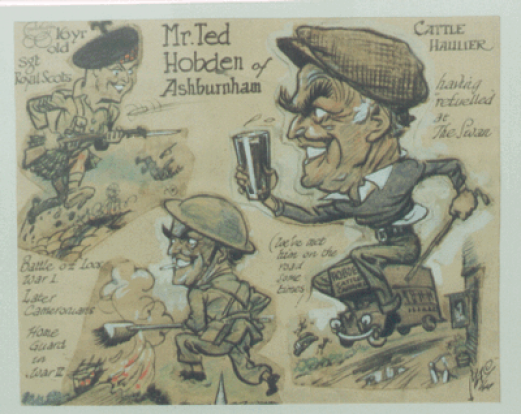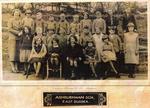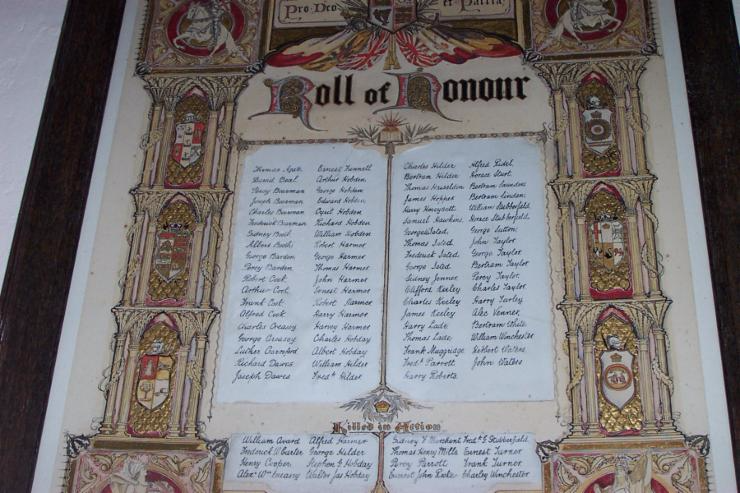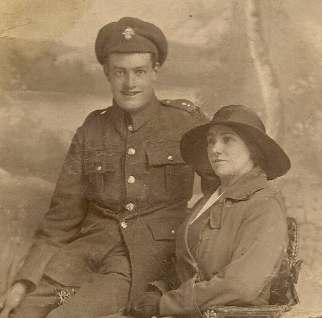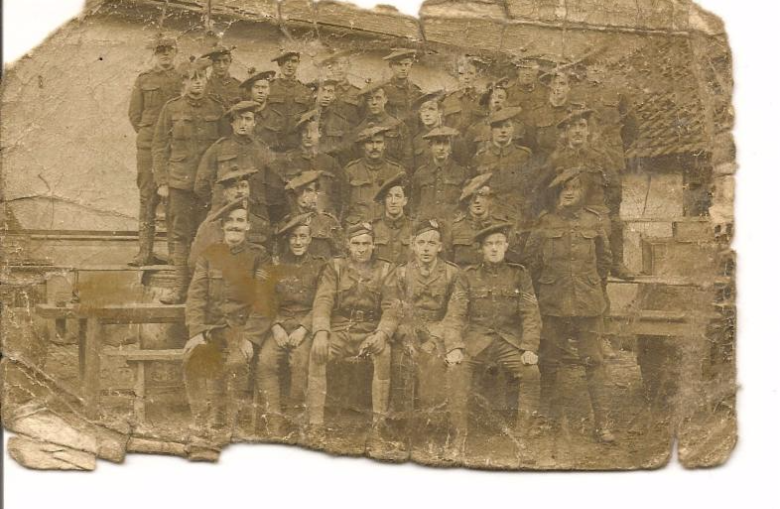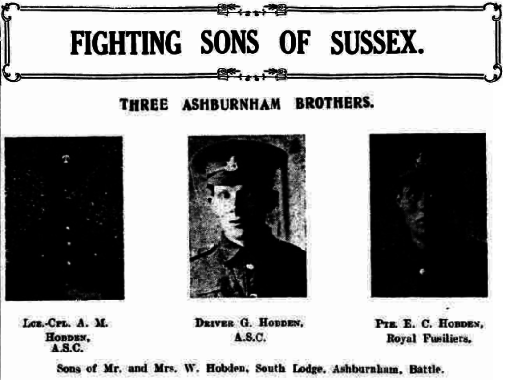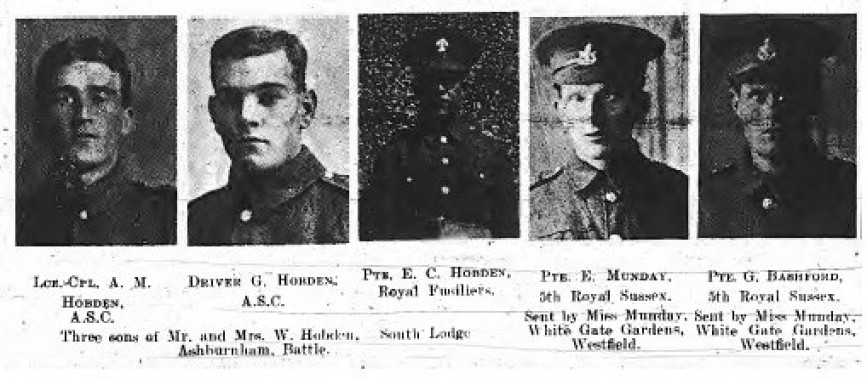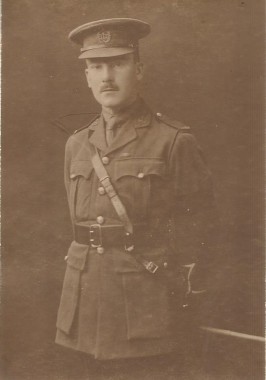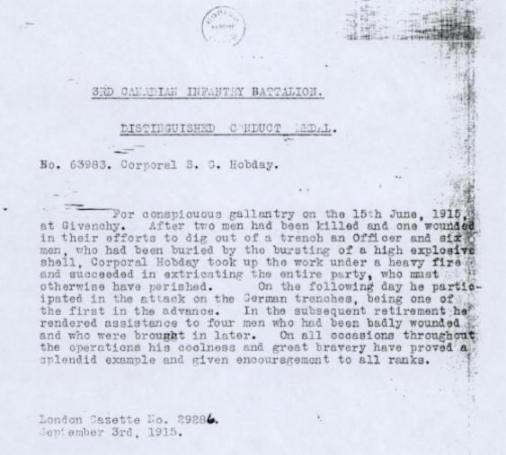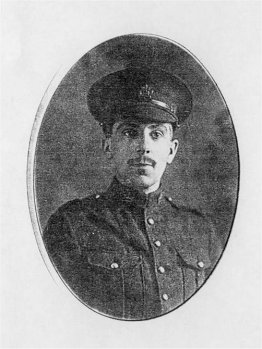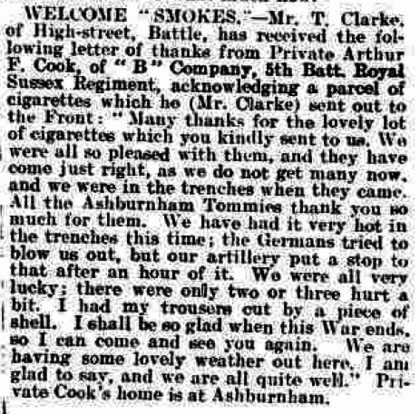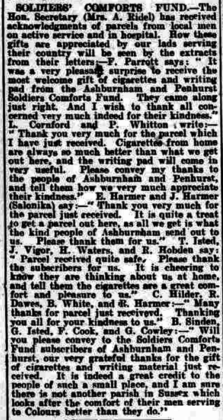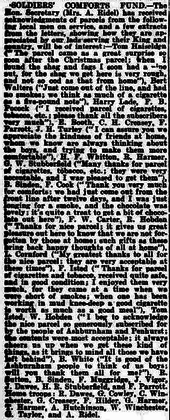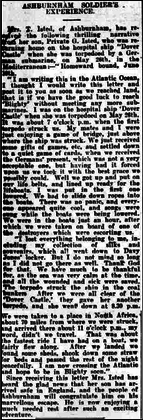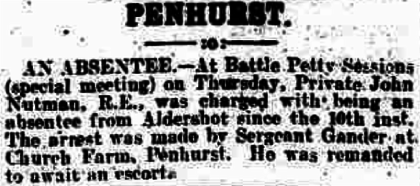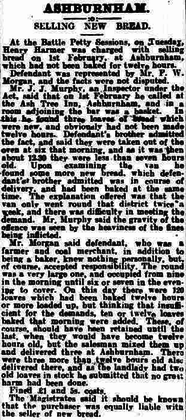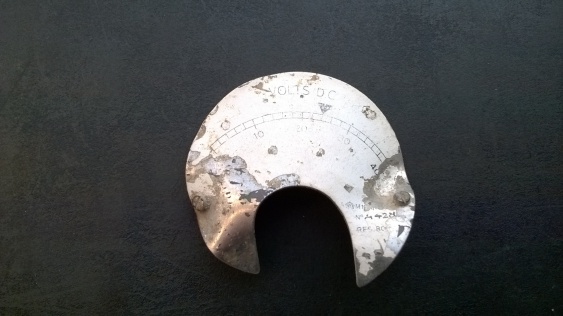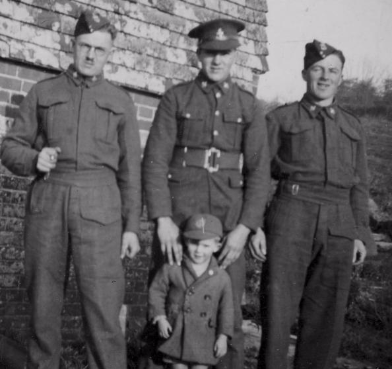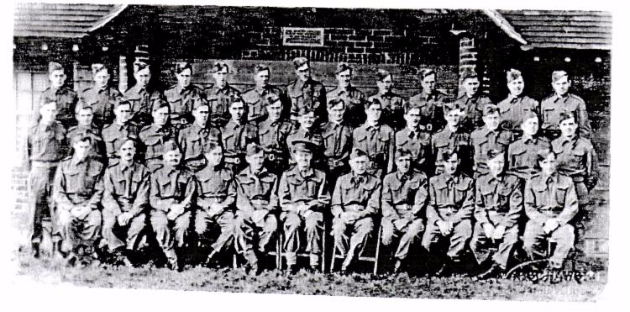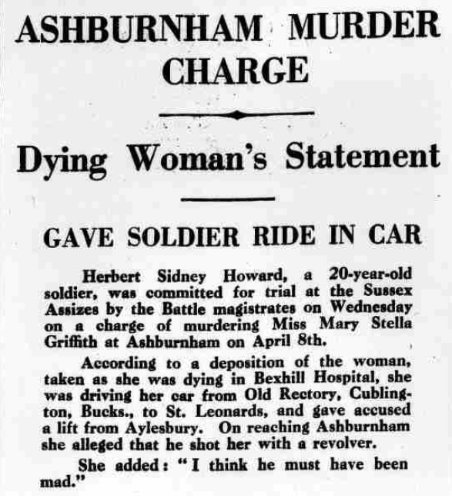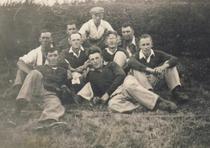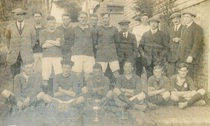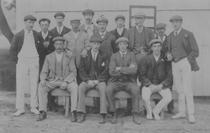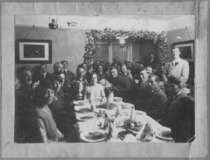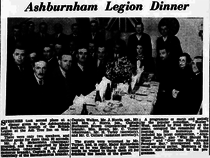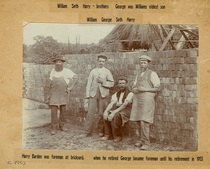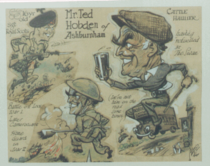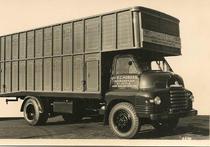People
Ashburnham County Primary School
From the London Gazette
Education Department, Whitehall, November 14, 1874.
THE Lords of the Committee of the Privy Council on Education have issued orders this day for the compulsory formation of School Boards in the undermentioned United
District:—
Ashburnham and Penhurst (parishes of Ashburnham and Penhurst) Sussex
(the village school, for both boys and girls, was established by the Earl of Ashburnham in 1866)
The Great War Roll of Honour
Edward Crawford Hobden (born 24th March 1899) lived at South Lodge with his parents and siblings. In 1915 he ran off and joined the Royal Fusiliers, seeing action at the Battle of Loos. A letter from his mother, pointing out his age, subsequently led to him being sent home! He returned a little while later serving with the Scottish Rifles (second row up, far right)
Men from Ashburnham & Penhurst Killed in Action
Frederick William Carter - private 5540, 7th Bn Leinster Regiment - died 24/11/1917
William Henry Cooper - private G/3885 2nd Bn Royal Sussex Regt - died 9/5/1915
Alex William Creasey - lance corporal SD/901 2nd Bn Royal Sussex Regt - died 4/10/1916
Alfred Harmer - private TF/2108 B Coy 1st/5th Bn Royal Sussex Regt - died 8/7/1915
George Hilder - private 203438 1st/7th Bn Middlesex Regt - died 10/4/1917
Stephen George Hobday DCM - lieutenant 3rd Bn Toronto Regt of Canada - died 8/10/1916
Walter James Hobday – private 24th Bn Victoria Rifles of Canada - died 16/6/1916
Thomas Henry Mills – private L/10348 2nd Bn Royal Sussex Regt – died 9/5/1915
Percy Parrott – private G/8872 11th Bn Royal Sussex Regt – died 2/4/1918
Ernest John Rooke – private L/7866 2nd Bn Royal Sussex Regt – died 9/5/1915
Frederick George Stubberfield – private TF/2611 1st/5th Bn Royal Sussex Regt – died 8/7/1915
Ernest Turner – private 21339 2nd Bn Hampshire Regt - died 23/4/1917
Francis Turner – private SD/2362 12th Bn Royal Sussex Regt - died 30/6/1916
Charley Winchester – private SD/752 C Coy 16th Bn Royal Sussex Regt – died 14/10/1918
The Day Sussex Died
The Battle of Boars Head - 30th June 1916
On the Ashburnham war memorial is Francis Turner who was one of the 392 men of the Royal Sussex Regiment, Southdown Battalions, killed on the 30th June 1916 at the Battle of the Boar's Head. In addition, Hubert Winchester and Harry Hobday, both born in Ashburnham, were also killed on that day. They are remembered on the Warbleton war memorial.
The 11th, 12th and 13th (Southdown) Battalions were raised by Claude Lowther MP of Herstmonceux Castle in September 1914, along the lines of the 'Pals Battalions', with companies formed of Eastbourne men, Hailsham men, Herstmonceux men, etc (each battalion had four companies with about 200 men in each company). Training commenced immediately at Cooden camp, continuing until May 1915 when the battalions moved to Detling then Aldershot then Witley Camp for further training. Finally on 4th March 1916 the Battalions sailed out of Southampton to Le Havre in France.
From Le Havre they were taken by train to Steenebeck Station and then marched onwards, eventually settling at Fleurbaix on the 12th March. The first casualty for the Southdowns happened on that day, David Thomas Dunk from Bexhill, who was killed by a sniper whilst entering the trenches.
The battalions spent the next month alternating time in the trenches, with time at billets, before being moved to the front line at Givenchy for a new cycle of fighting/resting. On the 9th May the battalions moved to Festubert and subsequently Cuinchy. By mid-June the battalions were moved to Richebourg St Vaast, the sector containing the Boar's Head.
A major, hopefully decisive, offensive was planned for the Somme on the 1st July 1916 so, to distract the enemy and give the idea that the main push was to be at Boar's Head, a diversionary action was set for the 30th June.
The 12th and 13th Battalions were moved into the front line for the attack, with the 11th Battalion supplying “fetch and carry” parties. Between 1,800 and 2,500 men went over the top from these battalions – 392 were killed, another 723 were wounded. The German front line was taken and held for 4 hours, the deeper support line for only half an hour. A heavy artillery barrage prevented reinforcements and supplies from getting through and the Sussex men had to withdraw. Despite the heavy losses, the distraction was considered a success – without it, the first day of the Battle of the Somme would have been an even darker day than it turned out to be.
Locally, the action had a huge impact - 9 men from Bexhill were killed on the 30th June 1916 or from wounds a few days later; 4 men died from Hailsham; 4 men died from Herstmonceux; 3 from Ashburnham; 2 from Brightling; 2 from Burwash; 1 from Battle; 1 from Burwash Common; 1 from Catsfield; 1 from Crowhurst; 1 from Heathfield; 1 from Netherfield. The Ashburnham postman, Arthur John (Jack) Miller was seriously wounded in his left arm and leg. After a long recovery, he was sent back to France and was killed at the Battle of Amiens in August 1918.
Local Casualties
Bexhill
11th Battalion
L/Cpl Archibald Botting G776
Pte Harry Mercer SD4810
Pte Edward Charles Taylor SD864
12th Battalion
Pte Reginald F Corke SD1875
13th Battalion
Pte Ernest Hewitt SD3146
Pte Cecil Honeysett SD2706
Pte James George Honeysett SD2707
CSM Edward James SD3790
L/Cpl Edward Page SD3417
Hailsham
12th Battalion
CSM Nelson Victor Carter VC SD4
Pte David Parsons SD1427
13th Battalion
Pte James George Gadd SD4213
L/Cpl Claude Leonard Toye SD3034
Herstmonceux
12th Battalion
Sgt Alfred Thomas Harris SD1887
13th Battalion
Sgt William Charles Duly SD3090
Pte William Stephen Smith SD3692
L/Cpl Robert Charles Veness SD4120
Ashburnham
12th Battalion
Pte Francis Turner SD2362
13th Battalion
Pte Harry Hobday SD3370
Pte Hubert Winchester SD3486
Brightling
12th Battalion
Pte Gilbert Croft SD2266
Pte William Wickens Pelling SD2248
Burwash
12th Battalion
L/Cpl Alfred Isted SD1894
13th Battalion
L/Cpl Charles Henry Funnell SD3768
Catsfield
13th Battalion
Pte (William) Frank Winchester SD5021
Battle
12th Battalion
Pte Frederick Catton SD2879
Burwash Common
12th Battalion
Pte Thomas William Hicks SD2102
Crowhurst
13th Battalion
Pte Frederick Walter Dann SD4013
Heathfield
12th Battalion
L/Sgt Charles Blackman SD1263
Netherfield
12th Battalion
Pte George Holland SD2103
The Battle of Aubers Ridge - 9th May 1915
The first battle to seriously affect the families back home in Ashburnham and Penhurst was the Battle of Aubers Ridge in France. Three men from the village, serving with the 2nd Battalion of the Royal Sussex Regiment, were to die in the battle - W H Cooper, T H Mills and E J Rooke. The first casualties of Ashburnham and Penhurst.
At 0500 on the 9th May 1915 artillery started bombarding the German defences 300 yards from the British line. The bombardment ended at 0540 and the men of the 2nd Battalion went over the top.
The artillery had made little effect though, seeming to only alert the Germans of the impending attack and there were soon many casualties from German machine gun, rifle and sniper fire. Some of the Sussex men made it to within 40 yards of the German defences only to find the barbed wire unbroken. According to the battalion war diary, only one man made it to the German trenches.
The order to withdraw was given at 0630 but many men were trapped in no mans land.
Out of around 850 men in the 2nd Battalion, 273 were killed on the 9th May 1915 with more subsequently succumbing to their wounds. Of the 273, more than 250 have no known grave.
Ashburnham WW1 News Stories
World War II
On D-Day, the 6th June 1944, a USAAF B-26 Marauder crashed in the grounds of Ashburnham Place, its bomb cargo ripping a huge crater
amongst the trees and causing extensive damage to the House and surrounding properties. The plane had iced up at high altitude and spun down out of control, colliding with another B-26 in a lower
formation. The other plane crashed at Ringletts Farm, Whatlington. Only one crew member managed to parachute to safety.
In Ashburnham and Penhurst, there were:
8 flying bombs
67 high explosive bombs
3 unexploded high explosive bombs
740 incendiary bombs
3 oil and phosphorus bombs
2 machine gun and cannon fire attacks
and from all that only 3 civilians were injured.
The house at Frankwell Farm was destroyed by a bombing raid in 1940, the current property being built in 1994.
Charles Douglas Ferguson - Corporal 6398937, 44th (7th Bn. The Queen's Own Royal West Kent Regt.) Regt. Reconnaissance Corps - died 10/5/1943
Ernest Charles Isted - sergeant 657163 149 Sqdn Royal Air Force - died 24/7/1942 (shot down over Geffen in Holland)
Ronald Arthur Turner - private 6401339 5th (Cinque Ports) Bn Royal Sussex Regt - died 22/5/1940
Clement Samuel Vincent Warrington - able seaman P/JX328995 HMLCT 7015 Royal Navy - died 18/10/1944
Frederick William Creasey - private 6403926 1st Bn Royal Sussex Regt - died 24/11/1941
David John Beale – private 6400575 5th Bn Royal Sussex Regt – died 27/10/1942 (photo below, flanked by his brothers Harry (left) and William (right), child unknown)
The Ashburnham Platoon of the 19th Battalion (Rother) Sussex Home Guard
Middle row, left to right: G Hutchinson, Arthur White, Arch Boorman, unknown, Ted Akehurst, Bert Stevens, Bill Carter, Mr Dimpleton, Melvin Taylor, George Veness, Frank Creasey, Stan Hobden, A Pont, A Saunders, Horace Brook
Front row, left to right: Dick Harman, Ernie Harmer, Bob Harmer, G Woodward, Mr Atkins, Capt Bickersteth, Mr Turley, C Collard, S Creasey, George Whyman, Charlie Winchester
Home Guard Auxiliary Unit
There were 23 such units across Sussex including one in Ashburnham.
The Ashburnham Patrol was made up of six members:
Eric Wilcox, a farm manager at Hooe
Joe Parsons, a local farmer
Eric Johnson, who farmed Boreham Farm
Joe Norris, who farmed Kitchenham Farm
Victor Dibben, a farmer from Hailsham
And Harold Pitcher, another local farmer
Harold Pitcher was later replaced by Ron Hart, a naval man from Hooe.
Their first hideout was in Pannelridge Wood, off Lakehurst Lane. There were problems however with damp and people finding the hideout, so it was blown up and a new hideout was made in Andersons Wood.
The new hideout was built by the Royal Engineers as an underground Nissan hut. It included a 50 foot long concrete tunnel as an emergency exit which came out in the bank of a stream.
The hideout contained bunk beds, food, water, ammunition and plastic explosives. In addition there were two small underground stores nearby containing extra food and ammunition.
The Ashburnham Patrol, together with the Crowhurst Patrol, were responsible for a mock attack on the Canadians stationed at Battle Abbey. The sentry was overpowered and the Commanding Officer taken prisoner, as well as dummy charges being attached to vehicles and fuel supplies. The Canadians didn’t like being made to look stupid and, in revenge, beat up the local Home Guard at the Chequers Inn, thinking them responsible!
Ashburnham WW2 News Stories
Hastings & St Leonards Observer 3rd May 1941
The threat of French invasion during the Napoleonic era necessitated a rudimentary home guard to be formed. As well as the Sussex Militia raised at this time, there was also the Sussex Troops of Gentleman and Yeoman Cavalry.
The Ashburnham Troop was raised on the 27th June 1798, subsequently disbanded in 1802 then reformed on the 17th November 1803. The Troop was finally disbanded by 1824.
The muster roll for persons enrolled in the Troop on the 1st August 1808 included the following:
Charles Lamb, Captain, enrolled 19/12/1803
Hon C Ashburnham, Lieutenant, enrolled 8/8/03
K Mosley, Cornet, enrolled 8/5/1807
From Ashburnham parish:
J L W Tatlow, enrolled 22/7/1806
Kd Phillips, enrolled 31/7/1803
Wm Pennington, enrolled 21/6/1803
John Smith, enrolled 21/6/1803
and 48 others from outside Ashburnham parish.
Ashburnham People
